13 Effective Foods To Improve Blood Circulation In The Body
Include the right foods in your diet to keep your circulatory system functioning properly.

Image: iStock
Proper circulation ensures proper blood oxygenation and blood flow throughout the body, allowing your body to function optimally. If you sit or stand for hours on end or feel numb, chances are, your blood flow is disrupted. While your blood circulation goes back to normal after some time, it may sometimes lead to health complications. To ensure that does not happen, this article discusses foods and several ways to improve your blood circulation naturally. Scroll down to check them out!
In This Article
What Is Poor Blood Circulation?
The circulatory system, also known as the cardiovascular system, is responsible for the transport of blood, oxygen, and nutrients throughout your body. When the blood flow to specific parts of your body is reduced, you start experiencing symptoms of poor blood circulation.
This condition is often a result of various health issues and factors. Some of the common causes are listed below.
What Causes Poor Blood Circulation?
- Peripheral Artery Disease: Peripheral artery disease (PAD) is a circulatory condition that causes your arteries and blood vessels to narrow. It can lead to poor blood circulation in your legs and lead to high blood pressure.
- Blood Clots: Blood clots can block the flow of blood to different parts of your body partially or entirely. Though they can develop anywhere in the body, blood clots that form in the arms and legs can cause poor circulation problems.
- Varicose Veins: When your veins become large as a result of valve failure, it results in varicose veins. The damaged veins can’t transport blood as efficiently as the normal ones, thus leading to poor blood circulation.
- Diabetes: Diabetes can also cause poor blood circulation in certain areas of your body. This is usually due to diabetic neuropathy.i Incurable nerve damage from high blood sugar levels over time that affects the nerves in the feet, causing pins and needles sensations.
- Obesity: Those who are overweight or obese may also face poor circulation problems on standing or sitting for long hours.
The following are some common symptoms associated with the condition.
What Are The Signs And Symptoms of Poor Blood Circulation?
- A tingling sensation
- Numbness
- A throbbing or stinging pain, especially in your limbs
- Muscle cramps
- Cold hands and feet
- Fatigue
 Quick Tip
Quick TipIf you experience any unusual sensation that points toward poor blood circulation, it is a good idea to consult your healthcare expert. You may also improve your condition using natural ways. We have put together some of the best foods and other natural ways that can help improve blood circulation throughout your body.
Best Foods That Increase Blood Circulation In The Body
- Blackberries
- Nuts
- Garlic
- Cayenne Pepper
- Ginkgo Biloba
- Ginger
- Watermelon
- Citrus Fruits
- Oats
- Dark Chocolates
- Avocados
- Salmon
- Beets
1. Blackberries
You Will Need
1 cup of blackberries
What You Have To Do
Consume a small cup of blackberries daily.
Why This Works
Regular consumption of blackberries is one of the best ways to improve blood circulation.
These berries are a rich source of various nutrients that stimulate the formation of new blood cells and purify your blood (1).
2. Nuts
You Will Need
A small cup of almonds and walnuts
What You Have To Do
Consume a small bowl of raw almonds and nuts on a daily basis.
Why This Works
Among nuts, almonds and walnuts are your best bets for increasing blood circulation. Both are rich sources of antioxidants that enhance blood supply by dilating your blood vessels (2).
3. Garlic
You Will Need
Minced garlic cloves
What You Have To Do
- Add raw minced garlic to your favorite dish and consume daily.
- You can also chew on garlic cloves directly.
Why This Works
Garlic contains allicin, which has powerful antioxidant properties that purify your blood and enhance blood supply and circulation. It also possesses anti-inflammatory properties that can help reduce inflammation in your body (3).
4. Cayenne Pepper
You Will Need
Raw or powdered cayenne pepper
What You Have To Do
Add fresh or powdered cayenne pepper to your favorite salads and dishes and consume daily.
Why This Works
Cayenne pepper
improves the functioning of the blood vessels, maintains blood vessel health, and reinforces your arteries. This is mainly due to its stimulating medicinal properties (4).
5. Ginkgo Biloba
You Will Need
- 1 teaspoon of ginkgo biloba tea
- 1 cup of hot water
- Honey
What You Have To Do
- Add a teaspoon of ginkgo biloba tea to a cup of hot water.
- Steep for 5 to 10 minutes and strain.
- Add some honey to it and consume immediately.
Why This Works
Ginkgo biloba contains flavonoids and terpenoids that render it most of its medicinal properties. Flavonoids are potent antioxidants that protect your body, including your heart and blood vessels, from free radical damagei Unstable atoms that can damage cells and lead to Alzheimer's and Parkinson's, heart disease, diabetes, and genetic diseases. thus maintaining heart health. The terpenoids in ginkgo biloba are responsible for dilating the blood vessels and improving blood circulation (5).
6. Ginger
You Will Need
Minced ginger
What You Have To Do
Consume freshly minced ginger daily by adding it to flavor your dishes and salads.
Why This Works
Ginger not only treats digestion and nausea but is also a great option for improving blood circulation The antioxidant and anti-inflammatory properties of ginger purify your blood and protect your body from free radical damage (6), (7).
7. Watermelon
You Will Need
A bowl of cut watermelon
What You Have To Do
Consume a bowl of cut watermelon daily.
Why This Works
The lycopene in watermelons helps enhance blood circulation due to its antioxidant properties (8). Some also prefer to take lycopene supplements to increase circulation.
8. Citrus Fruits

You Will Need
Citrus fruits
like oranges and grapefruits
What You Have To Do
Consume a portion of citrus fruits like oranges, grapefruits, and limes on a daily basis.
Why This Works
Citrus fruits are rich in vitamin C, an antioxidant. They also have strong anti-inflammatory properties that help reduce inflammation within the body. A combination of these properties helps in purifying your blood and enhancing circulation (9).
9. Oats
You Will Need
1 bowl of cooked oats
What You Have To Do
- Consume a bowl of cooked oats daily.
- You can also blend oats with your favorite smoothie and consume it.
Why This Works
Oats can work wonders in improving blood circulation throughout your body. They possess anti-inflammatory and antioxidant properties that help dilate your blood vessels and protect your body from free radical damage (10), (11).
10. Dark Chocolate
You Will Need
A small bar of dark chocolate
What You Have To Do
Consume a small bar of dark chocolate daily.
Why This Works
Dark chocolates are a rich source of cocoa, which contains flavonoids that have high antioxidant potential and enhance blood flow (12).
11. Avocados
You Will Need
A small bowl of cut avocados
What You Have To Do
- Add some cut avocados to your favorite salad and consume daily.
- Alternatively, you can also blend some avocado with milk to make a refreshing smoothie.
Why This Works
Avocados are rich sources of an amino acid called L-carnitine, which boosts metabolism, promotes fat loss, and increases blood circulation, especially in your brain (13), (14).
12. Salmon
You Will Need
1 portion of salmon
What You Have To Do
Consume a portion of marinated and cooked salmon every few days.
Why This Works
Salmon is a rich source of omega-3 fatty acids
that possess anti-inflammatory properties and boost the antioxidant potential of your heart (15), (16). This helps enhance your cardiovascular health and increases blood circulation.
13. Beets
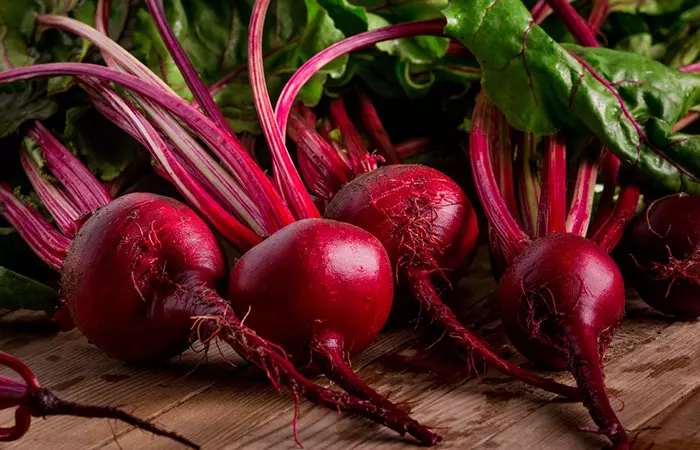
You Will Need
½ cup of beets
What You Have To Do
Consume ½ cup of beetroots daily. You can also include it in your Incorporate beets into salads or smoothies.
Why This Works
Beets are a remarkable natural remedy to boost blood circulation. They are rich in dietary nitrates that get converted into nitric oxide in the body. Nitric oxide works as a vasodilator. It relaxes the blood vessels and widens them. This dilation enhances blood flow, allowing oxygen and nutrients to reach different parts of the body more efficiently. So, beet consumption may boost overall circulation, potentially aiding in the management of high blood pressure (17), (18).
Regular consumption of beets may promote cardiovascular health and reduce the risk of circulatory problems.
Consuming the foods mentioned above will enhance your circulation while providing essential nutrients to support overall health. But is there anything else you can do for better blood circulation? Let us find out.
Other Natural Ways To Increase Blood Circulation In The Body
1. Essential Oils
a. Ginger Oil
You Will Need
- 12 drops of ginger oil
- 30 mL of any carrier oil (coconut or olive oil)
What You Have To Do
- Add 12 drops of ginger essential oil to 30 mL of any carrier oil.
- Mix well and massage this mixture all over your body for 2 to 5 minutes.
- Leave it on for 20 minutes and then take a bath.
How Often You Should Do This
Do this 2 to 3 times a week.
Why This Works
Ginger essential oil contains a compound called zingibain, which exhibits powerful antioxidant and anti-inflammatory properties that help reduce inflammation within and outside your body and fight free radical damage (19), (20). This ultimately results in improved blood circulation.
b. Eucalyptus Oil
You Will Need
- 12 drops of eucalyptus oil
- 30 mL of any carrier oil (coconut or olive oil)
What You Have To Do
- Add 12 drops of eucalyptus oil to 30 mL of any carrier oil and mix well.
- Gently massage this mixture all over your body.
- Leave it on for 15 to 20 minutes and then take a cold shower.
How Often You Should Do This
Do this 2 to 3 times a week.
Why This Works
Massaging is a great way to stimulate blood flow, and when essential oils are involved, the effects are multiplied. Eucalyptus oil contains eucalyptol that helps in dilating your blood vessels, thereby improving blood flow in your body (21).
2. Massage
A full body massage using any carrier oil is a great and widely accepted method to give a blood circulation boost throughout your body (22). Improved blood flow also promotes healing and wellness. You may opt for professional or therapeutic massage therapy, along with sauna therapy for added benefits (23)
3. Exercises And Yoga
Certain exercises, physical activities, and yoga poses can also aid in blood sugar control and stress reduction and improve your blood circulation. Given below are some exercises that you can add to your workout routine to improve blood circulation:
Exercises
a. Walking
How It Helps
Walking, being a cardiac exercise, can get blood pumping throughout your body.
Duration
20 to 30 minutes
b. Weight Training
How It Helps
Lifting weights not only helps in building muscles but also boosts blood flow and improves your cardiovascular health.
Repetitions
12 to 15
Note: Walking and weight training are also among the best exercises for heart health as well.
Yoga
a. Deep Breathing
How It Helps
As surprising as it sounds, a session of concentrated deep breathing can help increase your blood flow. When you breathe deeply, your muscles are relaxed. This, in turn, helps dilate the blood vessels, which helps improve blood circulation.
Repetitions
10
b. Tadasana (Mountain Pose)

How It Helps
The Mountain Pose improves blood circulation by increasing the elasticity of the blood vessels.
Duration
Hold this pose for 2 to 5 minutes.
c. Utkatasana (Chair Pose)
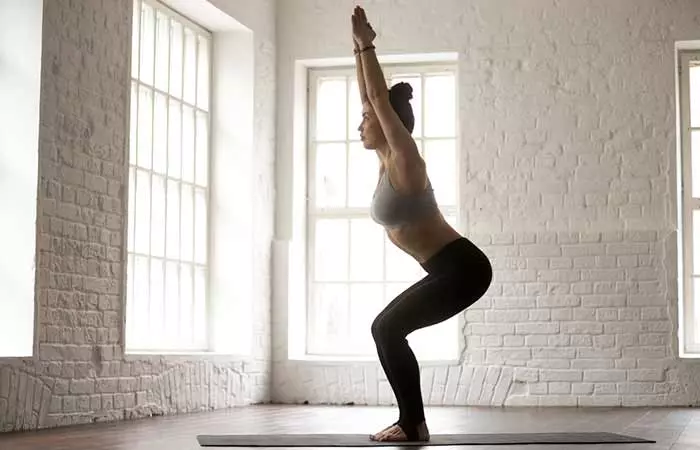
How It Helps
The Chair Pose helps to stretch your body and promotes blood flow to all organs.
Duration
Hold this pose for 30 seconds to 2 minutes.
d. Viparita Karani (Legs Up The Wall Pose)

How It Helps
This is one of the best exercises to increase blood circulation as it promotes blood flow to the lower extremities of your body.
Duration
Hold this pose for 5 to 15 minutes
4. Acupressure
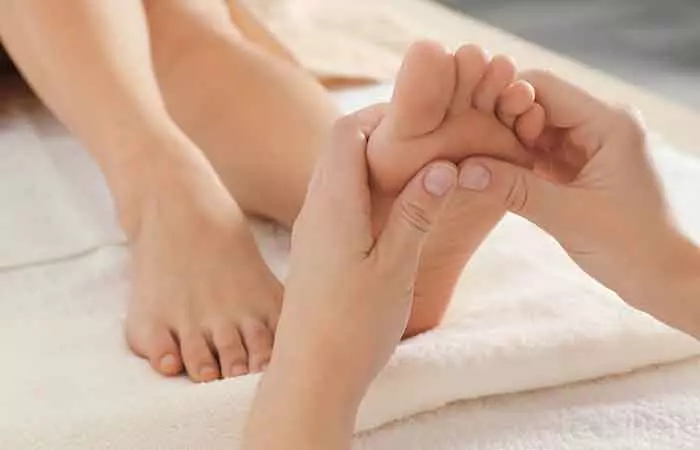
Acupressure is a therapy that involves massaging certain acupoints on the foot. This, along with acupuncture, is known to strengthen your immune system and improve blood circulation throughout your body (24).
5. Avoid Drinking Alcohol
Alcohol consumption can affect the natural circulation of blood. Therefore, you need to avoid drinking alcohol to make the other methods more effective.
6. Keep Yourself Well Hydrated
Drink enough water and keep yourself well hydrated to enhance the blood flow throughout your body.
Infographic: More Simple Ways To Improve Blood Circulation In The Body
We all do things that lead to poor blood circulation, including our diet and lifestyle. The good news is that you no longer have to endure poor circulation. Start by using the suggestions in the infographic below for your day-to-day activities to help improve blood flow throughout your body. Illustration: StyleCraze Design Team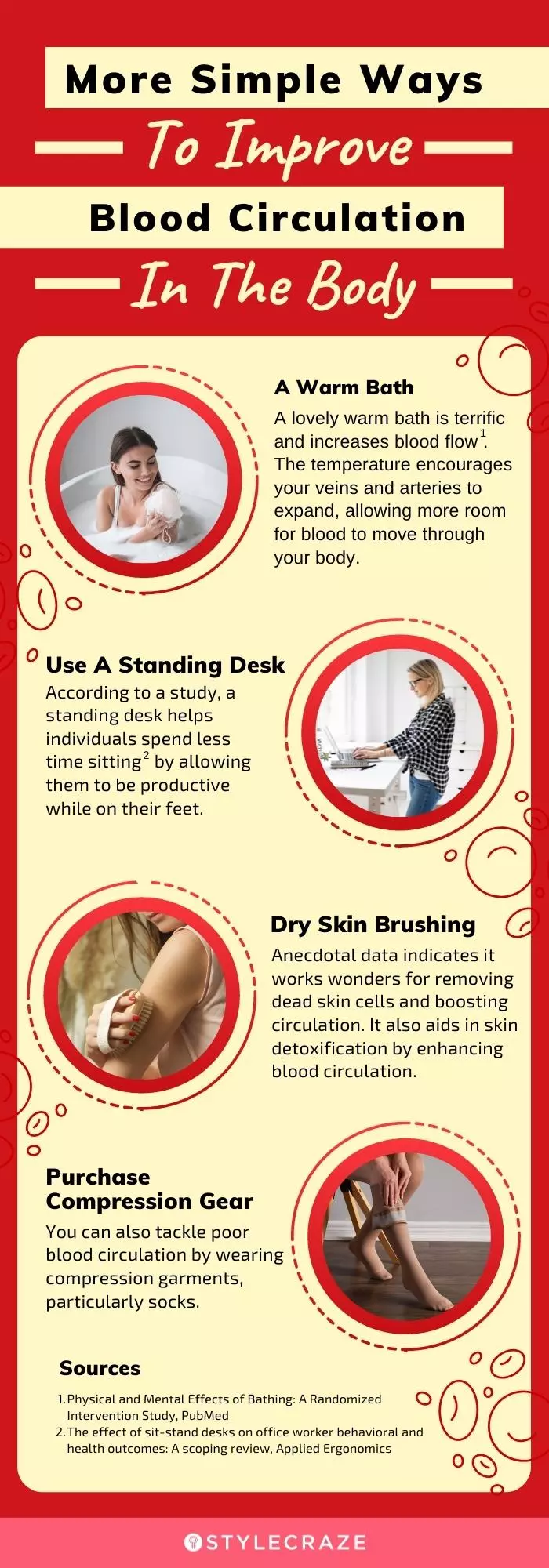
 Quick Tip
Quick TipPoor blood circulation limits the amount of blood and its constituent oxygen and nutrients that reach the body parts where the blood flow is reduced. Multiple factors and health issues may impact proper blood circulation like obesity, diabetes, varicose veins, blood clots, and arterial disease. Numbness, tingling, muscle cramps, and throbbing pain are common signs of poor blood flow. Proper hydration and certain foods can improve blood circulation, and you may want to incorporate them into your diet if you experience any of the symptoms mentioned earlier. Food options include blackberries, citrus fruits, watermelon, nuts, garlic, dark chocolate, and cayenne pepper.
Frequently Asked Questions
What happens if you stop the blood circulation in your hand or other body parts?
When you cut off the blood supply to your hands or legs, they will go numb in a few minutes due to the absence of oxygen in the neurons. This will further result in the absence of any sensation, and your hands or legs may also turn blue.
How long does it take to improve blood circulation?
Poor blood circulation may lead to adverse health effects later in life. Hence, it is necessary to follow a healthy diet, practice meditation, and exercise regularly to maintain proper blood circulation (25).
What vitamins should I take to improve blood circulation?
You may increase your intake of foods rich in vitamins B, C, and E like milk, eggs, cheese, poultry, citrus fruits, leafy vegetables, soy, and nuts to improve blood circulation.
What pills help circulation?
Medications like pentoxifylline and blood thinners may help increase circulation. It helps reduce the viscosity of the blood and increases blood flow (26).
Does vitamin B12 help with circulation?
Yes, vitamin B12 can help with circulation. Intake of vitamin B12 with folic acid has been found to increase coronary blood flow (27).
Is magnesium good for circulation?
Magnesium helps improve endothelial functioni The membrane inside veins manages the electrolytes and fluids in the blood and releases substances that impact BP and heart risks. , myocardial metabolismi An essential function that produces chemical reactions to power heart function, allowing it to circulate oxygenated blood. , and vascular issues. Therefore, the intake of magnesium may help improve circulation (28).
Key Takeaways
- Feeling numb after being stationary for some time could indicate improper blood circulation.
- Obesity and diabetes are the common reasons for poor blood circulation. Varicose veins, artery disease, and blood clots are the other possible reasons.
- Healthy habits like exercise, proper diet, drinking enough water, and avoiding smoking and alcohol are the best home remedies to improve blood circulation.
- Massaging with essential oils, acupressure techniques, and wearing compression stockings reduces inflammation and improves blood flow.
Illustration: Effective Foods To Improve Blood Circulation In The Body
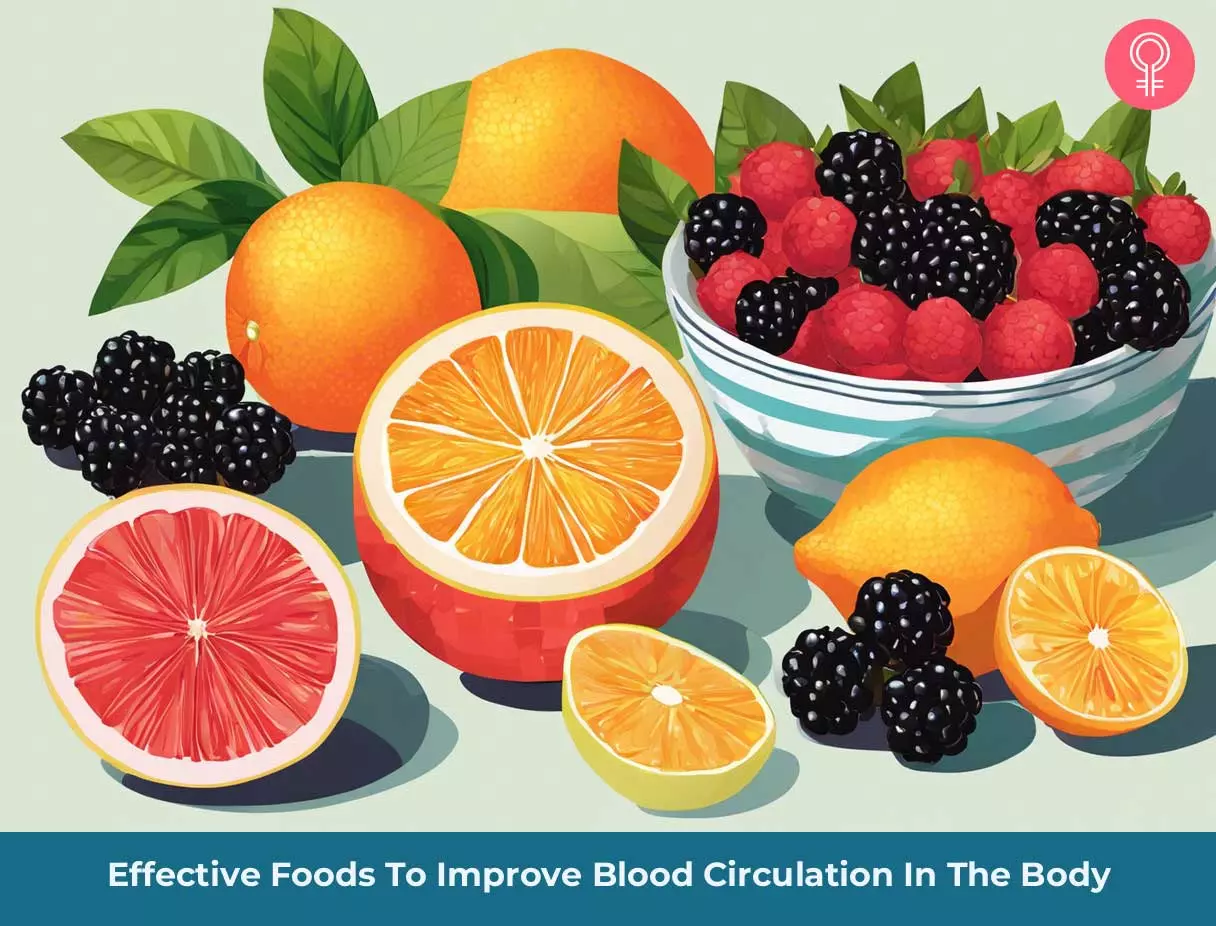
Image: Stable Diffusion/StyleCraze Design Team
Click on the video presented below to uncover a dozen extraordinary foods that can enhance blood circulation in your legs and explore the untold secrets that others won’t divulge!
References
Articles on StyleCraze are backed by verified information from peer-reviewed and academic research papers, reputed organizations, research institutions, and medical associations to ensure accuracy and relevance. Read our editorial policy to learn more.
- Recent Research on the Health Benefits of Blueberries and Their Anthocyanins
https://academic.oup.com/advances/article/11/2/224/5536953 - Health Benefits of Nut Consumption
https://www.ncbi.nlm.nih.gov/pmc/articles/PMC3257681/ - Effect of garlic on cardiovascular disorders: a review
https://www.ncbi.nlm.nih.gov/pmc/articles/PMC139960/ - Blood Circulation Stimulation Properties of Cayenne Pepper:A Review
https://www.researchgate.net/publication/326060740_Blood_Circulation_Stimulation_Properties_of_Cayenne_PepperA_Review - Effects of Ginkgo biloba on cerebral blood flow assessed by quantitative MR perfusion imaging: a pilot study
https://www.ncbi.nlm.nih.gov/pmc/articles/PMC3163160/ - Ginger on Human Health: A Comprehensive Systematic Review of 109 Randomized Controlled Trials
https://www.ncbi.nlm.nih.gov/pmc/articles/PMC7019938/ - Anti-Oxidative and Anti-Inflammatory Effects of Ginger in Health and Physical Activity: Review of Current Evidence
https://www.ncbi.nlm.nih.gov/pmc/articles/PMC3665023/ - Effects of Oral Lycopene Supplementation on Vascular Function in Patients with Cardiovascular Disease and Healthy Volunteers: A Randomised Controlled Trial
https://www.ncbi.nlm.nih.gov/pmc/articles/PMC4049604/ - The effects of flavanone-rich citrus juice on cognitive function and cerebral blood flow: an acute randomised placebo-controlled cross-over trial in healthy young adults
https://pubmed.ncbi.nlm.nih.gov/28091350/ - Antioxidant capacity of oat (Avena sativa L.) extracts. 2. In vitro antioxidant activity and contents of phenolic and tocol antioxidants
https://pubmed.ncbi.nlm.nih.gov/10606549/ - Anti-inflammatory activities of colloidal oatmeal (Avena sativa) contribute to the effectiveness of oats in treatment of itch associated with dry irritated skin
https://pubmed.ncbi.nlm.nih.gov/25607907/ - Effects of dark chocolate and cocoa consumption on endothelial function and arterial stiffness in overweight adults
https://pubmed.ncbi.nlm.nih.gov/24274771/ - Cerebral blood flow in patients with chronic cerebrovascular disease: effect of acetyl L-carnitine
https://pubmed.ncbi.nlm.nih.gov/2387659/ - Glycine propionyl-L-carnitine modulates lipid peroxidation and nitric oxide in human subjects
https://pubmed.ncbi.nlm.nih.gov/20209464/ - Omega-3 fatty acids (fish oil) as an anti-inflammatory: an alternative to nonsteroidal anti-inflammatory drugs for discogenic pain
https://pubmed.ncbi.nlm.nih.gov/16531187/ - Do fish oil omega-3 fatty acids enhance antioxidant capacity and mitochondrial fatty acid oxidation in human atrial myocardium via PPARγ activation?
https://pubmed.ncbi.nlm.nih.gov/24597798/ - Beetroot A Remarkable Vegetable: Its Nitrate and Phytochemical Contents Can be Adjusted in Novel Formulations to Benefit Health and Support Cardiovascular Disease Therapies
https://www.ncbi.nlm.nih.gov/pmc/articles/PMC7600128/ - Physiology Vasodilation
https://www.ncbi.nlm.nih.gov/books/NBK557562/#:~:text=Vasodilation%20is%20a%20mechanism%20toa%20reduction%20of%20blood%20pressure. - Anti-Inflammatory Effects of the Essential Oils of Ginger (Zingiber officinale Roscoe) in Experimental Rheumatoid Arthritis
https://www.ncbi.nlm.nih.gov/pmc/articles/PMC5115784/ - Antioxidant anti-inflammatory and antinociceptive activities of essential oil from ginger
https://pubmed.ncbi.nlm.nih.gov/24020099/ - Vasodilatory Effect of Alpinia officinarum Extract in Rat Mesenteric Arteries
https://www.mdpi.com/1420-3049/27/9/2711 - Massage therapies
https://www.ncbi.nlm.nih.gov/pmc/articles/PMC1071543/ - The Cardiometabolic Health Benefits of Sauna Exposure in Individuals with High-Stress Occupations. A Mechanistic Review
https://www.ncbi.nlm.nih.gov/pmc/articles/PMC7908414/ - Evaluation of the Effects of Acupuncture on Blood Flow in Humans with Ultrasound Color Doppler Imaging
https://www.ncbi.nlm.nih.gov/pmc/articles/PMC3388479/ - Short-term meditation increases blood flow in anterior cingulate cortex and insula
https://www.ncbi.nlm.nih.gov/pmc/articles/PMC4341506/#:~:text=Short%2Dterm%20meditation%20increases%20blood%20flow%20in%20anterior%20cingulate%20cortex%20and%20insula - Pentoxifylline
https://www.ncbi.nlm.nih.gov/books/NBK559096/ - Coronary blood flow in patients with stable coronary artery disease treated long term with folic acid and vitamin B12
https://pubmed.ncbi.nlm.nih.gov/21389855/ - Magnesium and cardiovascular system
https://pubmed.ncbi.nlm.nih.gov/20353903/
Read full bio of Caroline Duncan
Read full bio of Shaheen Naser
Read full bio of Arshiya Syeda
Read full bio of Dipti Sharma





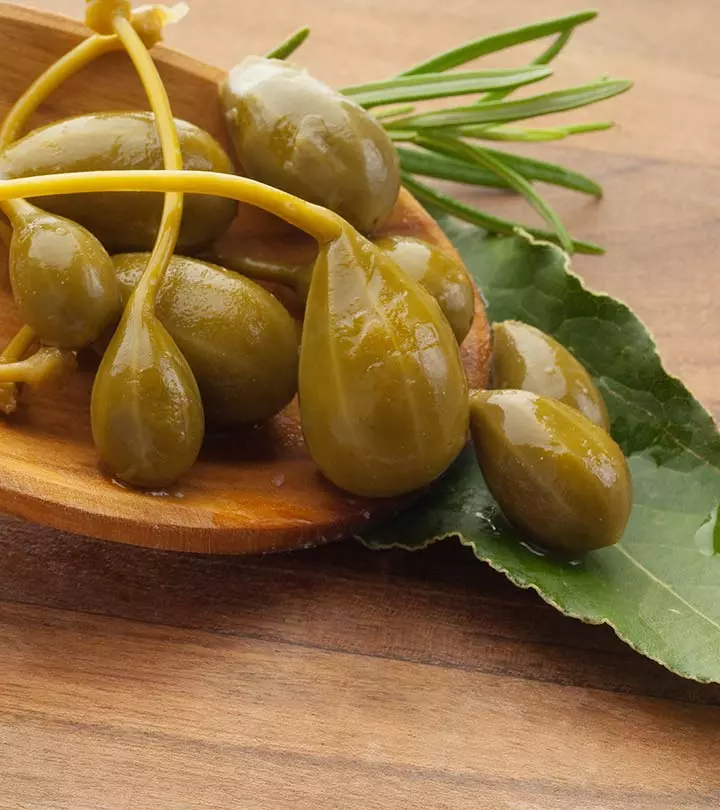
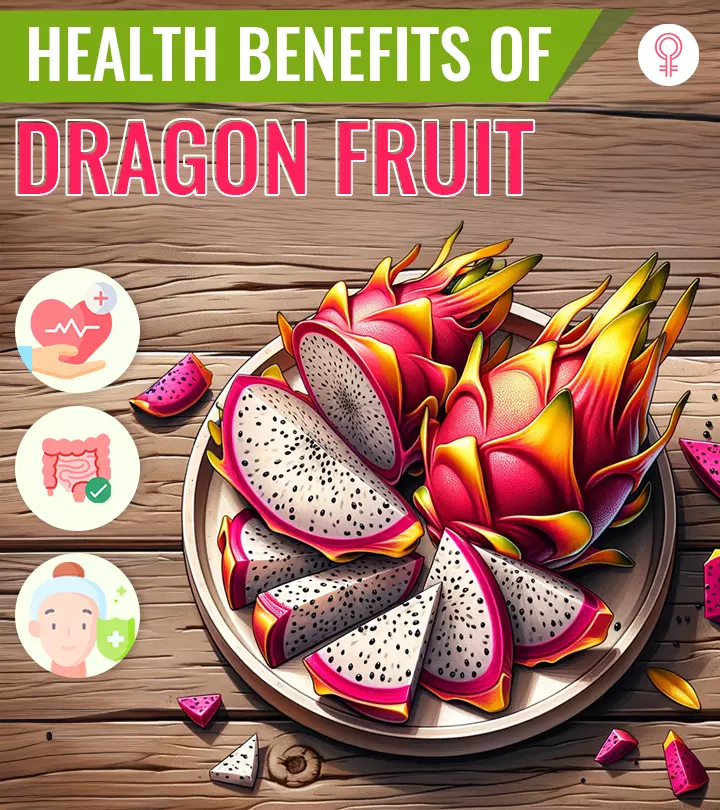

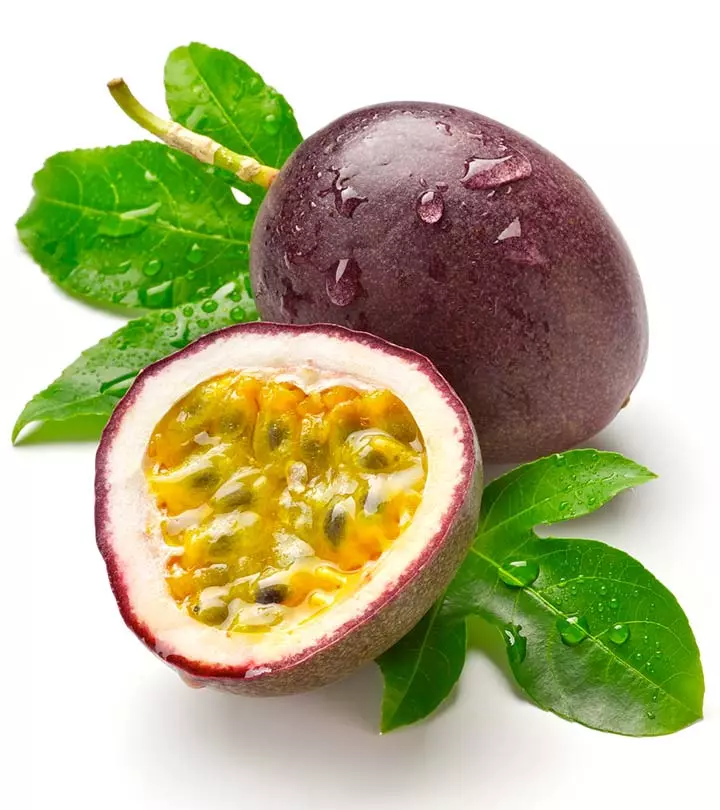


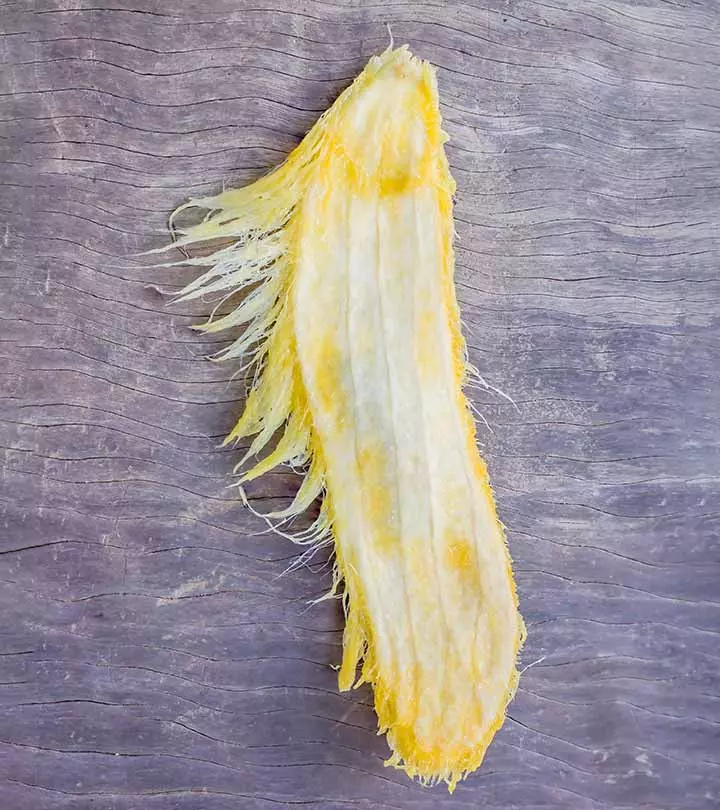





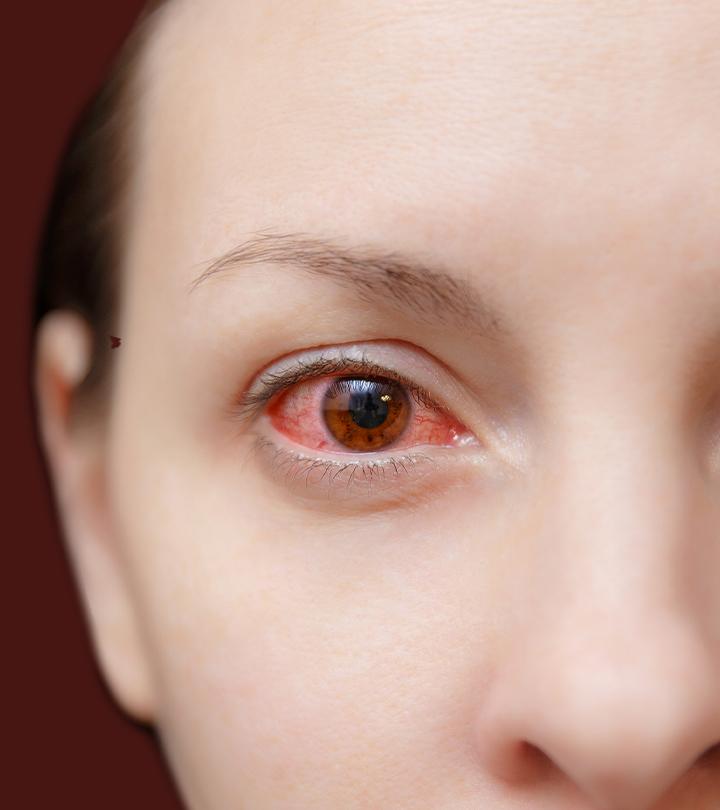


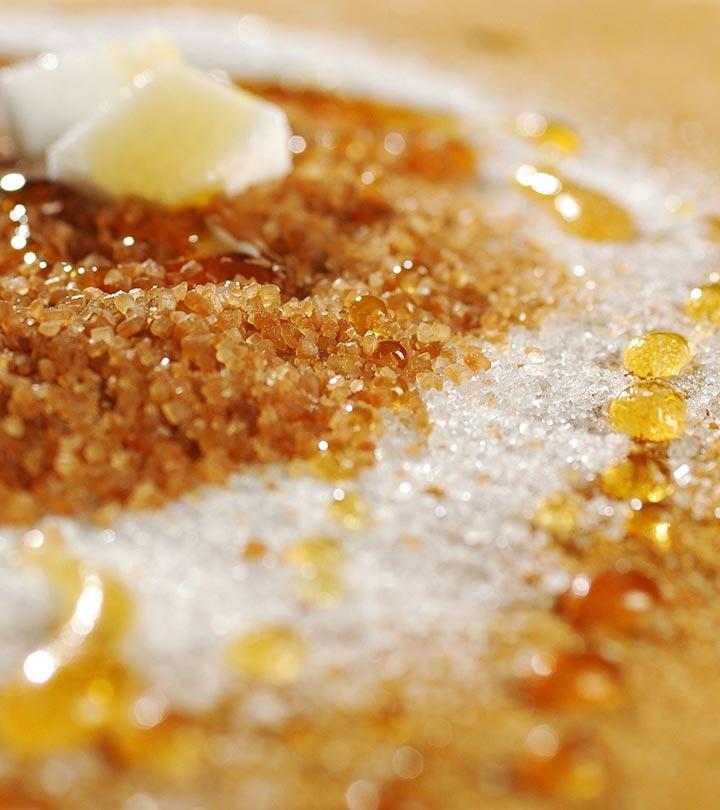





Community Experiences
Join the conversation and become a part of our empowering community! Share your stories, experiences, and insights to connect with other beauty, lifestyle, and health enthusiasts.